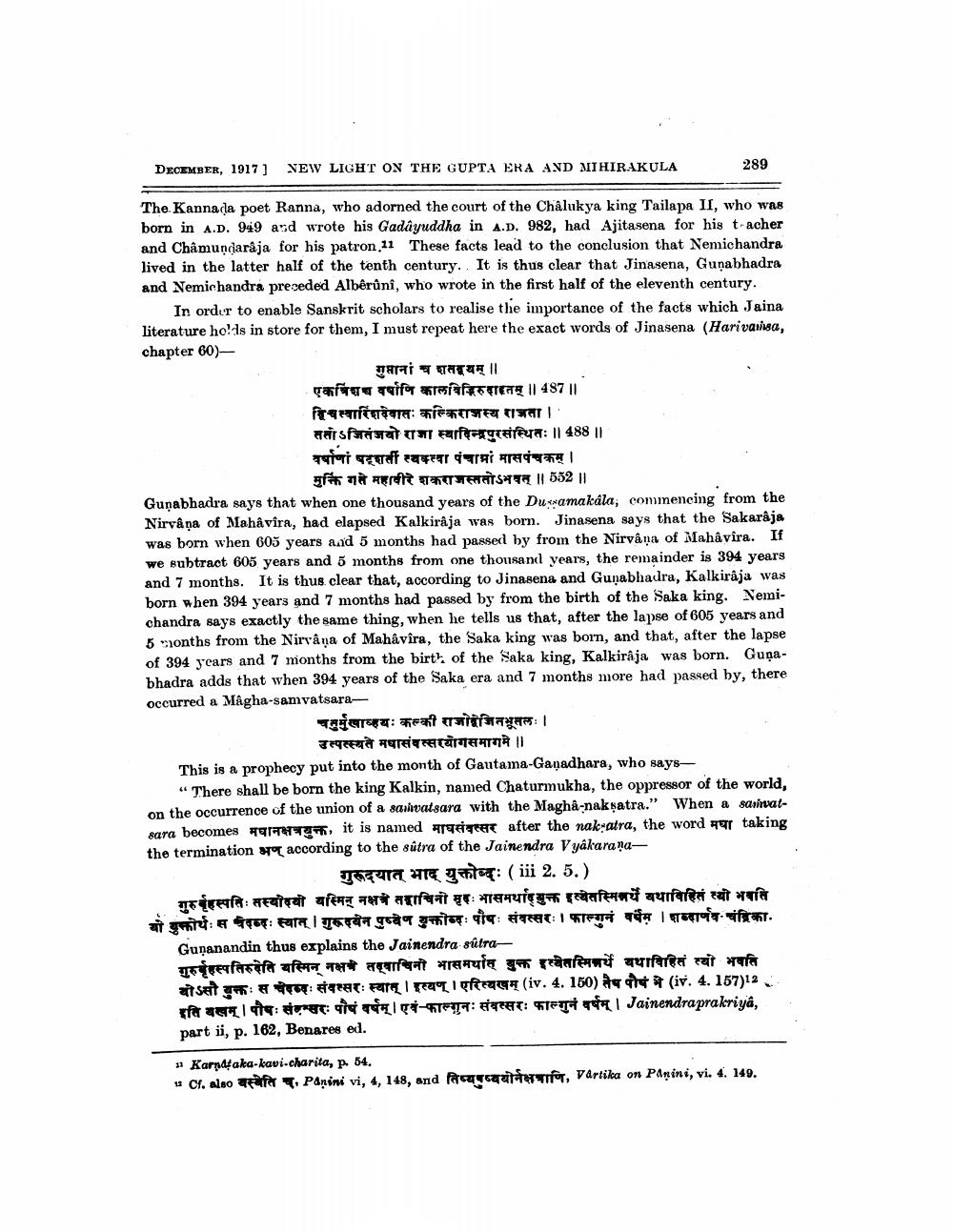________________
DECEMBER, 1917] NEW LIGHT ON THE GUPTA ERA AND MIHIRAKULA
289
The Kannada poet Ranna, who adorned the court of the Châlukya king Tailapa II, who was born in A.D. 949 and wrote his Gadâyuddha in A.D. 982, had Ajitasena for his t-acher and Châmundaråja for his patron 11 These facts lead to the conclusion that Nemichandra lived in the latter half of the tenth century. It is thus clear that Jinasena, Gunabhadra and Nemichandra preceded Albêrûni, who wrote in the first half of the eleventh century.
In order to enable Sanskrit scholars to realise the importance of the facts which Jaina literature holds in store for them, I must repeat here the exact words of Jinasena (Harivansa, chapter 60)
गुप्तानां च तदयम् ।। एकत्रिंशच वर्षाणि कालविनिरुवाहतम् ।। 4870 विचत्वारिंशदेवासः कल्किराजस्य राजता । सतोऽजितंजवो राजा स्वादिन्द्रपुरसंस्थितः ।। 488 ।। वर्षाणां षट्शाती त्वक्त्वा पंचामां मासपंचकम् |
मुक्ति गते महावीरे शकराजस्ततोऽभवत् ।। 552॥ Gunabhadra says that when one thousand years of the Duxramakala, commencing from the Nirvâņa of Mahavira, had elapsed Kalkirâja was born. Jinasena says that the Sakarâja was born when 605 years and 5 months had passed by from the Nirvana of Mahâvîra. If we subtract 605 years and 5 months from one thousand years, the remainder is 394 years and 7 months. It is thus.clear that, according to Jinasena and Gunabhadra, Kalkiraja was born when 394 years and 7 months had passed by from the birth of the Saka king. Nemichandra says exactly the same thing, when he tells us that, after the lapse of 605 years and 5months from the Nirvana of Mahavira, the Saka king was born, and that, after the lapse of 394 years and 7 months from the birth of the saka king, Kalkiraja was born. Gupabhadra adds that when 394 years of the Saka era and 7 months more had passed by, there occurredaMAgha-samvatsara
चमुर्मुखाव्हयः कल्की राजोइजिनभूतलः ।
उत्पत्स्यते मधासंवत्सरयोगसमागमे ।। This is a prophecy put into the month of Gautama-Ganadhara, who says
“There shall be born the king Kalkin, named Chaturmukha, the oppressor of the world, on the occurrence of the union of a sasivatsara with the Maghå-nakyatra." When a sariwatsara becomes मघानक्षत्रयुक्त, it is named माघसंवत्सर after the nakatra, the word मघा taking the termination for according to the sutra of the Jainendra V yakarana
गुरुदयात् भाद् युक्तोब्दः (iii 2.5.) गुरुहस्पतिः सस्योदयो यस्मिन् नक्षत्र सहाचिनी मृदः भासमादयुक्त इत्येतस्मिन्नर्थे यथाविहितं त्यो भवति यो मुक्तोः स तब्दः स्थान | गुरुदयेन पुष्वेण युक्तोदः पौषः संवत्सरः। फाल्गुनं वर्षेम | शब्दार्णव- चंद्रिका.
Gunanandin thus explains the Jainendra sutraगुरुर्तृहस्पतिरुदेति यस्मिन् नक्ष सवाचिनो भासमर्थात् बुक्त स्वेतस्मिन्नर्थे यथाविहितं त्यो भवति बोऽसौ युक्तः स चेवनः संवत्सरः स्थात् । इत्यण् । एरित्यखम् (iv. 4. 160) तेष पौष भे (iv. 4. 137)12.. इति बखम् । पौषः संहसरः पौषं वर्षम् । एवं-फाल्गुनः संवत्सरः फाल्गुनं वर्षम् | Jainendraprakriya, part ii, p. 162, Benares ed.
11 Karpdf aka-kavi.charita, p. 54. ucralso बस्वेति च Panini vi, 4, 148, and तिष्यषष्यबोर्नक्षत्राणि, Vartika on Pagini,vi. 4. 149.




